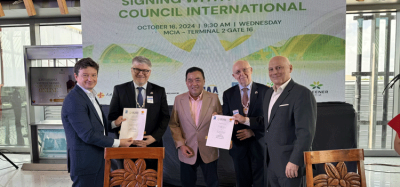Is collaboration the answer to airport’s environmental challenges?
- Like
- Digg
- Del
- Tumblr
- VKontakte
- Buffer
- Love This
- Odnoklassniki
- Meneame
- Blogger
- Amazon
- Yahoo Mail
- Gmail
- AOL
- Newsvine
- HackerNews
- Evernote
- MySpace
- Mail.ru
- Viadeo
- Line
- Comments
- Yummly
- SMS
- Viber
- Telegram
- Subscribe
- Skype
- Facebook Messenger
- Kakao
- LiveJournal
- Yammer
- Edgar
- Fintel
- Mix
- Instapaper
- Copy Link
Posted: 20 March 2015 | Sharon Mahony, Project Leader, EUROCONTROL
Everyday environmental impacts, in general noise and emissions, are significant constraining factors for efficient and sustainable airport operations, particularly in Europe, due to their effect on the quality of life and health of local communities. The industry is also under pressure to reduce its greenhouse gas emissions. In order to tackle these challenges, EUROCONTROL has recently launched the Collaborative Environmental Management (CEM) specification, as Project Leader Sharon Mahony explains.


As a result of the environmental challenges facing aviation today, news stories relating to the impact of aviation on the lives of millions of people are a constant feature of our daily lives. The media abounds with articles, often about local communities protesting about proposed expansions of airports or building new runways, or about politicians debating the impacts, both positive and negative, in the light of the current economic and political climate.
As a consequence, social and political pressures on airports are growing in importance. This can be seen in night-time flying bans, noise limitations and the construction of new runways being permitted only with operating restrictions. Environmental permit renewals are being challenged in court and the resulting consultation and mitigation process can take many years to resolve. In the meantime, current operations can be restricted and this can affect capacity and flight efficiency.
Although numerous stakeholders operate at an airport, the public often regards the airport operator as the most visible entity responsible for its environmental impacts. These mounting public concerns, together with media reporting and increasing regulation, have made the management of such issues a critical priority for airport stakeholders.
To add to the debate, the economic importance of the aviation sector as generators of business and employment is widely recognised. It has been estimated that, in Europe alone, air transport supports 12.3 million jobs (direct, indirect, induced, and catalytic impacts), according to a recent study commissioned by ACI EUROPE ‘The Impact of an Airport’1. These include people working for airlines or handling agents, directly for airport operators, on-site at airports for government agencies such as customs and security, or providing services in retail outlets, restaurants, hotels, etc.
To maintain these economic benefits while responding to environmental challenges in times of uncertain growth and speculative markets, operational stakeholders will need, more than ever, to work together within a harmonised, widely accepted and robust process that local authorities, regulators and local businesses and communities can trust and engage with.
Sustainable growth
Given that airports are increasingly becoming the choke points for the European air traffic management network, it is essential for the future efficiency of that network, that there is widespread acceptance that airports should be in a position to grow their traffic in a sustainable and responsible manner. Airport operators cannot ensure this alone, and thus must collaborate with aircraft operators and their air traffic organisations to manage traffic and its impact in a manner acceptable to regulators, politicians and the public.
Significant efforts have already been made by operational stakeholders at airports to address the environmental impacts that are caused by air traffic operations. There are some excellent and visible examples of work done together with local authorities and airport neighbours on securing their acceptance of an airport to operate and grow in a sustainable manner. Vienna International Airport’s Dialog Forum established in 2005 is one of them. Within this Forum there is the opportunity to discuss issues of concern with neighbouring communities, political parties and NGOs together with ATC and Airlines. Other issues, such as possible improvements of the environmental situation and the future development of the airport, are also raised. Benefits from the Dialog Forum (www.dialogforum.at) can be seen in the acceptance of the airport and its future development plans by the surrounding communities and local authorities.
However, despite these considerable efforts, a significant number of medium to large airports across Europe are currently encountering either real difficulties when they need to grow or capacity constraints on their operations, all for environmental reasons.
As a result, the aviation sector recognises that something more needs to be done to facilitate and embed a more harmonised and sustained approach to addressing the ‘environmental challenge’ at airports. ‘Collaboration’ and ‘a collaborative approach’ are terms that we see more and more on the agendas of industry partners and trade associations and in related policy documents and position papers (e.g. IATA2 , CANSO3, ACI4, ATAG5). However, until recently, no single harmonised generic approach has been identified as a means to facilitate the sustainable development of airports and to ensure that the associated environmental impacts are understood and addressed.
Harmonised specification
In 2013, in response to this growing environmental challenge, EUROCONTROL decided, together with key operational and industry stakeholders, to draft an innovative process driven Specification* for Collaborative Environmental Management (CEM) at airports.
The objective of the CEM Specification6 is to formalise collaboration among the core operational stakeholders at airports by setting out generic, high level requirements and recommended practices necessary to establish CEM working arrangements articulated through a written protocol. The generic, high level requirements allow for local needs and conditions to be taken into consideration when setting up CEM working arrangements. These cover all air transport operations and their environmental impact at and around an airport (i.e. on the ground and in the air). It is not bound to a specific airport size or number of movements.
Here for example are some topics that the CEM working arrangements can cover:
- Aircraft related noise management (e.g. enhanced noise track adherence)
- The reduction in atmospheric emissions (both local air quality and greenhouse gas emissions)
- Fuel conservation (as a scarce resource) and reduced engine running times
Topics range from simply responding to complaints to implementing major mitigation projects such as Continuous Descent Operations (CDO) or looking at increasing the usage of Fixed Electrical Ground Power (FEGP).
Other areas that can be addressed include locally determined air transport related environmental issues such as water management, waste management, soil and groundwater contamination, the operational impact of de-icing solutions, third party risk issues, bird hazard management and biodiversity.
Through the CEM working arrangements, key operational stakeholders’ common awareness and understanding of the interdependencies and constraints facing each other’s business is facilitated. In turn, this can enable the development of collaborative environmental solutions, implemented through joint planning and performance monitoring. Each stakeholder can then take away actions on agreed decisions for incorporation into its own relevant business and operational processes.
To ensure that the CEM Specification was fit for purpose, objective and agreed at a European level, EUROCONTROL submitted it to a transparent and rigorous public consultation process. The results of this process, open to all possible stakeholders, both public and private, showed strong support for this innovative and unique approach not only to tackle environmental challenges at the local level but also as a means for the sustainable development of airports in general. The CEM Specification was published in September 2014.
Developing a culture of environmental awareness
A vital element in the successful implementation of the CEM Specification’s collaborative approach is ensuring that considering environmental impacts becomes embedded in normal operational processes, in the same way as with safety. Operational stakeholders working together, to improve operational efficiency or capacity, also need to work in partnership to understand and address the environmental impact of proposed actions and, if necessary, jointly identify robust mitigation solutions that are acceptable to all parties.
Effective communication, both between stakeholders and also within each stakeholder organisation is key to their mitigation solutions being accepted, developed and implemented. This also concerns other stakeholders in the airport, such as ground handling agents, who also have an interest in collaborating and communicating on their environmental challenges and priorities.
When an airport is developing its environmental strategy, the CEM working arrangements can thus play a vital role in ensuring that all stakeholders are represented and can agree a way forward.
To sum up, CEM is a way of thinking. It joins the dots between operational and environmental challenges and teams working together at airports; and it can facilitate understanding of the environmental benefits of operational improvements – an aspect that is often overlooked.
As a result of the publication of the EUROCONTROL CEM Specification, increasing numbers of ANSPs, airport operators and aircraft operators are now sitting down around the table, discussing their environmental challenges and looking at interdependencies and the impacts of potential mitigation measures.
With the social and media pressure around airports not about to disappear, the implementation of CEM working arrangements by operational stakeholders can send a strong signal to regulators and policy makers that a robust and harmonised approach is being taken internally to address an airport’s environmental challenges and to implement collaborative solutions. It is crucial to build internal commitment and vision among the CEM partners before engaging with external stakeholders, such as planning authorities and local community representatives. Buy-in from respective CEOs is another essential – it is not always about quick wins!
As a measure of its credibility and usefulness to stakeholders, the EUROCONTROL CEM Specification has already been endorsed by ACI-Europe as Recommended Practice (03/14)7 for Noise Abatement issues at airports, and has been shortlisted for the IHS Jane’s ATC Awards 2015 in the Environmental category.
At the official launch of CEM in November 2014, Olivier Jankovec, Director General ACI EUROPE said: “Environmental management is a core issue for European airports. Over the years, we have been addressing critical priorities like carbon emissions, noise and local air quality with tailored approaches. In the collaborative environment of an airport, bringing these processes together is a natural next step. Working with EUROCONTROL to develop Collaborative Environmental Management has been very positive, and the result provides our members with a blueprint for an even more robust and transparent dialogue with their airlines and ANSPs aimed at identifying the best possible solutions to jointly address environmental impacts.”
In conclusion, to maintain optimal operational and environmental performance in ATM, there is a growing realisation amongst stakeholders that they cannot achieve this acting individually, that collaboration is the key and that the CEM working arrangement process is part of the solution.
*EUROCONTROL Specifications have a voluntary status and are developed to support Member States and stakeholders. This specification may provide a possible means of compliance with certain requirements related to SES and aviation environment related legislation.
References
- The Impact of an Airport, ACI EUROPE, January 2015
- Carbon Neutral Growth from 2020: FOUR-PILLAR STRATEGY, IATA, June 2007
- Accelerating Air Traffic Management Efficiency : A call to Industry, CANSO, February 2012
- Environment & Airports and the Environment ACI Position Brief, ACI, March 2007
- Towards Sustainable Aviation 2012 Position Paper 6th Aviation & Environmental Summit, ATAG, March 2012
- eurocontrol.int/articles/collaborative-environmental-management-cem-specification
- aci-europe.org/component/downloads/downloads/4059.html
Biography
Sharon Mahony has been with EUROCONTROL in Brussels since 1988, initially with the Central Route Charges Office then in the Human Resources Directorate. She is now working in the Directorate Pan-European Single Sky. Through this she has gained a unique experience and insight into both operational and support roles in the aviation world. In her current role as an Aviation Environmental Analyst Sharon is leading the implementation of Collaborative Environmental Management (CEM) across Europe, following the publication of the EUROCONTROL CEM Specification for which she was responsible. Prior to EUROCONTROL she worked in the private sector. She holds an honors degree in Psychology and is currently studying for a Masters in Environment, Politics and Globalisation at King’s College London.


















